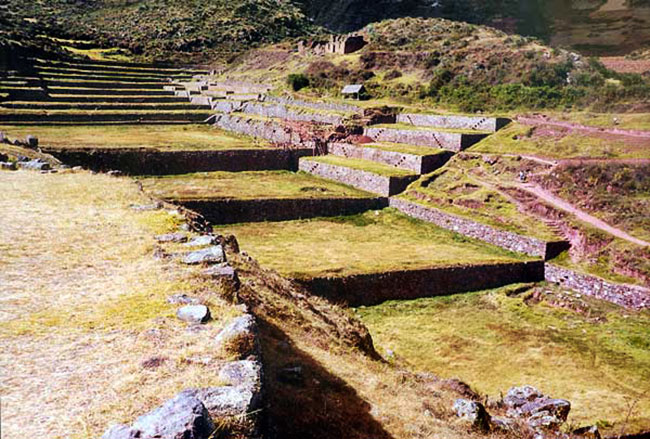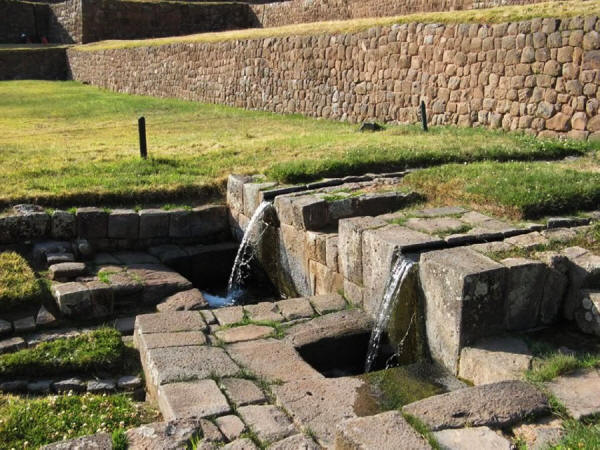|

by A. Sutherland
May 01,
2019
from
AncientPages Website

Cusco Tipón terraces
There are many unanswered questions regarding the Inca's marvelous
engineering
masterpiece known as Tipón.
How did the Inca
manage to reach this high level of development?
What was the source
of their advanced knowledge of hydraulics?
Nowhere else in
Tawantinsuyu ("Land of the Four Quarters") as the Inca used to refer
to their empire, are there so well-planned and carefully finished
agricultural terraces and irrigating channels as in the Tipón
complex.
The original name of this Inca site is lost in time; however, Dr.
Luis Antonio Pardo, the prominent Peruvian historian, believes
that the current name of Tipón may derive from the Quechua word 'Tuxeuj'
("to be boiling").
It is believed that
Tipón's walled agricultural enclosure was built by earlier people of
the Cusco Valley.
As narrated by Inca Garcilaso de la Vega (1539 – 1616), a chronicler
and writer, apparently, Tipón was part of the royal estate belonging
to Inca Yawar Huaca (Yawar Waqaq), the seventh Sapa Inca of the
Kingdom of Cusco (beginning around 1380 AD).
In his book "Tipón: Water Engineering Masterpiece of the Inca
Empire", Kenneth R. Wright writes:
"The balance of Tipón
is mostly covered by walled terraces for both irrigated and dry
land farming. The exceptions are some upper slopes too steep for
terraces and a huge, smooth, volcanic rock slab that is so steep
that it will not hold topsoil.

Tipón - home to one of the largest
irrigation works in terraces,
with many outdoor water channels.
image source
The massive outer wall of Tipón, 15 to 20 feet high and nearly 4
miles long, encircles the community. The wall provided security
and firmly established the perimeter of this estate.
Tipón was a perfect location for the Inca nobility to construct
an estate.
Its perennial spring,
adjacent streams on the east and west, and fertile volcanic
soils were coupled with an already walled agricultural enclosure
built by earlier people of the Cusco Valley…"
At the same time, Tipón
was devoted to religious ceremonies and agricultural experiments.
The site that dates back
to the beginning of 15th century, is located at 3,560
meters above sea level, about 23 km southeast of Cusco, in the
district of Oropesa (province of Quispicanchis), along the
Cusco-Puno road.
It covers 239 hectares and consists of enclosures and wide
agricultural terraces irrigated by a network of water channels fed
by a natural spring.
Tipón - A
Laboratory of Agricultural Products
Besides being an archaeological complex, Tipón is home to one of the
largest irrigation works in the terraces, with a great distribution
of outdoor water channels.

This beautiful compound of agricultural terraces, long stairs and
stone canals is located 20 km south of the city of Cuzco.
One can think of Tipón as the largest artificially irrigated Inca
garden or rather an unusual complex of garden-like structures rising
on many levels and on dozens of stone terraces.
This was garden laboratory, probably used for experimenting with
agricultural products, utilizing the various micro-climates found
within the complex.
It can be assumed that Tipón was a similar place for Inca
agronomists, as
Moray (Moroy), famous for its oval
farm terraces. Moray, located in the Sacred Valley of the Incas, has
an old but very sophisticated irrigation system.
Probably like in Moray,
also in Tipón, the Incas experimented with the cultivation of new
plant varieties of potatoes, corn, and other plants.
To these activities, they needed water that flowed through fine
stone structures (aqueducts, spillways, canals and falls) and farm
terraces situated at many different levels.
Having proper conditions,
the Inca plants could grow at different temperatures and with
different sun exposure.

The
hydraulic engineering of the Tipón fountain
represents a high standard of care to create
an
aesthetic amenity.
Credits: Wright Water Engineer
Therefore, the terraces rise from the bottom of the valley to its
upper edge, while water flows here through aqueducts and canals,
freely adjusted.
Centuries ago, the Tipón ingenious complex was most likely destroyed
by the Incas themselves, who did not want to leave it in the hands
of the Spaniards.
After many years, the complex was reconstructed and restored to its
former glory.
Tipón was once an
important, specially protected place and it is evidenced by a large,
oval fort that rises on the northern flank of the complex.
|





